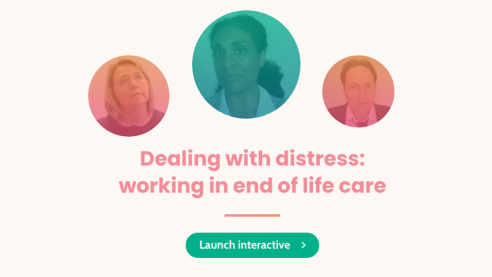This content is associated with The Open University's Health and Social Care courses and qualifications.
Walking the Walk is an experienced-based approach to quality improvement. It has previously been successfully utilised in acute hospitals, care homes, and GP surgeries. It draws on people’s lived experiences to provide settings with feedback and recommendations about the care environment. It involves three stages: scene setting, the walk-through, and feedback provision (see Figure 1 below).
Figure 1: The Three Stage Process for Walking the Walk.
We know that for parents and families, it’s often the small things that matter and make the most difference. We know too that staff want to get it right, but they don’t always have the insight to see what is really important and valued at such a time (Hardy, 2018).
Working with Evelina London Children’s Hospital
The walk-through involved two bereaved parents (recruited by the hospital) and two experienced Walking the Walk leaders. When in clinical areas, they were joined by two senior clinicians (Nurse specialist from the Child Death Review Team and Paediatric Palliative Care Consultant). As they walked from the ‘front door’ throughout hospital spaces, they noted key environmental features and processes of care, considering how they might be experienced by the family of a dying child. They considered both what was working well and what could be improved.
The areas visited included public spaces (e.g. shops, eating areas, chapel/multi-faith prayer spaces). They were unescorted by any host organisation team member, and engaged with resources such as signage, volunteers and relevant staff as if they were a member of the public wanting to find a location or seek advice. They additionally visited clinical areas: intensive care units (neonatal and paediatric), wards, bereavement office, bereavement midwifery suite, Emergency Department, parent accommodation, the mortuary – including the journey parents take to the mortuary once their child has died.
Feedback was presented in person at the end of the visit to the host organisation, with representatives from senior management and hospital directors. This was followed by a written report, highlighting issues and themes that hospital teams may not have perceived to impact families. Ideas were grouped into four themes: environment; access to care and support; involvement in care; and care after death and bereavement support.
Positive examples included hoists in family accommodation, access to green spaces, and food and drink provision (parent lounges, coffee shops, dining areas, etc.), as well as games and distracting artwork on walls for the children. Examples of areas to improve included confusing signage, a lack of pens by the book of remembrance, and difficulty accessing prayer rooms.
On wards and in the emergency department, the walk highlighted the need for large, neutral spaces where professionals and families could meet – without these areas doubling up for purposes like equipment storage, departmental education (display boards) or team breaks. It also showcased the benefits of bereavement suite spaces for babies, children and young people of all ages. When accessing the mortuary, the team highlighted how the presence of objects like industrial dustbins, plain tarpaulin used on concealment trolleys, and selection (or absence) of wall art can have a negative impact on families. This showed the importance of educating staff on why families access such spaces, and the need for compassionate design within them. The report also highlighted subtle observations, such as a ‘stopped clock’ in family rooms signifying time standing still or stopping for the families.
Feedback from parents
Parent representatives shared how initially there was some trepidation about revisiting the hospital, with the memories this could evoke, but they felt prepared and supported via the Walking the Walk format.
For these two mothers it was a way to ‘give back’ to a team of people to whom they felt great gratitude, and to support the intention of improving the experience for other parents. One of the mothers said:
‘At the Evelina we were always made to feel a part of the discussion; our views were important, and staff took the time and effort to ask the questions that mattered, to know our wishes, rather than making assumptions and this helped form a relationship of trust.’
Being able to provide feedback directly to senior staff demonstrates the perceived value of the initiative to the organisation in its ambition to prioritise end-of-life care. A member of the team emailed afterwards to say that having parents in the room and hearing directly from them contributed to ‘being the most moving feedback and the best in their entire career in the NHS’.
Conclusion
To make effective change, observation can play a vital role. Lessons gained from the Walking the Walk approach offer a rich source of learning and can be used to supplement data routinely collected, such as audit results, user feedback through complaints and compliments, and staff experience. The feedback from the host colleagues suggests this approach is highly adaptable and offers a fresh perspective in efforts to improve the care experience, especially in the context of the end of life and bereavement.







Rate and Review
Rate this article
Review this article
Log into OpenLearn to leave reviews and join in the conversation.
Article reviews